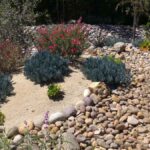
The best grasses for Boulder are buffalograss, Kentucky bluegrass, and the fescues because they do well in our arid climate and rocky soil and survive our chilly winters intact.
Even though the soil here in Boulder can be a little … rocky … these grasses enable you to have an attractive lawn, provided you also have a good maintenance program. Many factors contribute to choosing the best type of grass for your lawn, including your elevation, soil type, sun and shade conditions, and how much foot traffic the area gets. Here, we’ve narrowed down the list to the best grass types for Boulder.
Buffalograss

Cool-season grasses are best in most of Colorado, but buffalograss is one warm-season grass that thrives here. It’s a native grass that has very low maintenance needs and does well in sunny areas. With about 300 sunny days a year here, this would be an excellent choice if your lawn doesn’t have many shade trees. It is drought-tolerant, is not susceptible to many lawn diseases, and doesn’t get infested by pests easily.
Native buffalograss thrives in the western and central regions of the Great Plains. These regions are drier than areas to the east and have progressively shorter grasses. As the name suggests, native buffalograss is a primary forage grass for grazing animals in this region, including the American bison.
One drawback to buffalograss is its open growth habit, meaning it doesn’t grow densely like some turfgrasses. This allows weeds to intrude in the spaces between the blades. So with buffalograss, you’ll either have to accept the natural mix of grass and weeds or adopt an aggressive weed-control program to keep them out.
Buffalograss at a glance
Classification: Warm-season grass
Spreads by: Stolons
Shade tolerance: Very low — best suited for full sun
Drought resistance: High
Foot traffic tolerance: Very low, but light use or rare heavy use is OK
Maintenance needs: Low mowing frequency — once per week or less
Mowing height: 2-4 inches or leave unmowed
Potential for disease: Good tolerance against diseases and insects
Soil pH: 6.5-7.5
Soil type: Native soils, not sandy soils
Grass Seed Options:
– Everwilde Farms Buffalograss Seeds (1 lb. of seeds)
– Scotts Pursue Buffalograss with Natural Seed (1 lb. of seeds)
Kentucky Bluegrass

If you have the time and energy to put into your lawn, Kentucky bluegrass is one of the most beautiful grasses you can have. Its deep blue-green color and soft texture make it an ideal choice for those who want a lush, dense lawn. We recommend using a blend of 2-5 different cultivars of KBG for the best outcome.
However, Kentucky bluegrass requires a good bit of maintenance. It needs more water than most grasses, needs to be fertilized three times a year for best results, and is prone to thatch accumulation. It is also vulnerable to several diseases. Combining it with perennial ryegrass makes for a more resilient lawn.
Kentucky Bluegrass at a Glance
Classification: Cool-season grass
Spreads by: Rhizomes
Shade tolerance: Low
Drought tolerance: Moderate
Foot traffic tolerance: Moderate
Maintenance needs: Moderate mowing frequency and high fertilization needs.
Mowing height: Set mowing height between 2.5 and 3.5 inches.
Potential for disease: Moderate to high; prone to several diseases, such as dollar spot, leaf spot, necrotic ring spot, summer patch, and stripe smut.
Soil pH: 6-7.5
Soil type: Performs best in well-drained, heavy soils with high fertility.
Grass Seed Options:
– Jonathan Green (11970) Blue Panther Kentucky Bluegrass Grass Seed (3 lbs.)
– SeedRanch Midnight Kentucky Bluegrass Seed (5 lbs.)
Fine Fescue

Aaron J. Patton, Ph.D. / Turfgrass Extension Specialist at Purdue University
This group of cool-season grasses is low-maintenance and drought-tolerant. Perfect for Boulder’s mile-high elevation because of their low nitrogen needs and tolerance of very cold weather, fescues grow well in infertile or sandy soil.
Note that fine fescue is NOT the best option for high-traffic lawns. It does not recover quickly from injury and does not hold up well where kids and pets play or in yards that host regular backyard get-togethers. Fine fescue is also prone to thatch development, so although it is low maintenance in other areas, dethatching is necessary.
Here are some commonly used fine fescue varieties:
- Creeping red fescue: Fine texture; excellent shade tolerance; high cold tolerance; good to excellent drought tolerance; good to excellent salt tolerance
- Chewings fescue: Moderate to quick establishment rate; excellent shade tolerance; good to excellent drought tolerance
- Sheep fescue: Excellent drought tolerance; good to excellent resistance to red thread disease
- Hard fescue: Fine texture; excellent drought tolerance; excellent shade tolerance.
Fine fescue at a glance
Classification: Cool-season grass
Spreads by: Creeping red fescue spreads by rhizomes, while other fine fescues are bunch-type grasses, such as Chewings, hard, and sheep fescues.
Shade tolerance: Moderate to high, depending on species
Drought tolerance: Moderate to high, depending on species
Foot traffic tolerance: Low to moderate, depending on species
Maintenance needs: Low fertilizer and mowing needs
Mowing height: Set mowing height between 2.5 and 4 inches, depending on species.
Potential for disease: Moderate. Common diseases include red thread, leaf spot, dollar spot, summer patch, and powdery mildew.
Soil pH: 6-6.5
Soil type: Will not perform well in wet soil conditions. Prefers drier soils and tolerates a wide range of soil types and fertility.
Grass Seed Options:
– Outsidepride Legacy Fine Fescue Grass Seed (5 lbs.)
– Eretz Creeping Red Fine Fescue Seed (choose your size)
– Outsidepride Creeping Red Fine Fescue Grass Seed (25 lbs.)
– Outsidepride Hard Fine Fescue Grass Seed (10 lbs.)
Tall Fescue

Aaron J. Patton, Ph.D. / Turfgrass Extension Specialist at Purdue University
This is a great choice for Boulder because the summers can be hot, and tall fescue tolerates heat better than all other cool-season grasses, so it will stay green longer. It also grows well in clay soils with a lot of organic matter.
Tall fescue germinates rapidly and prefers full sun but will grow well in partially shady environments. It also adapts to multiple soil conditions. Homeowners appreciate that it has low fertilization needs and does not form significant thatch.
When tall fescue is properly maintained, it resists disease very well. However, wet conditions promote diseases and pest infestation. So, well-drained soil is important if you want a healthy lawn with minimal maintenance efforts.
Tall fescue may seem like a great choice to establish a new lawn quickly because it germinates fast. However, it spreads slowly. Another disadvantage of tall fescue is that it does not repair quickly when damaged, so this is not the best grass choice for lawns that get a lot of use. We recommend overseeding it to improve its resilience.
Tall fescue at a glance
- Classification: Cool-season grass
- Spreads by: Produces short rhizomes but has a bunch-type growth habit
- Shade tolerance: Moderate
- Drought tolerance: Moderate to high
- Foot traffic tolerance: Moderate
- Maintenance needs: Frequent mowing. Does not produce significant thatch.
- Mowing height: Set mowing height to 2 inches when grass reaches 3 inches tall.
- Potential for disease: Tolerant of most diseases when properly maintained.
- Soil pH: 5.5-6.5
- Soil type: Adapted to a wide range of soil conditions, but prefers fertile clay soils with good drainage.
- Other notes: To produce a thriving and attractive lawn, use turf-type tall fescue grass seed. Forage-type varieties do not produce quality lawns.
Grass Seed Options:
– Triple-Play Tall Fescue Grass Seed Blend (5000 sq ft)
– Eretz Kentucky 31 K31 Tall Fescue Grass Seed (choose your size)
– Pennington The Rebels Tall Fescue Grass Seed Mix (7 lb.)
Which Grass Seed is Right for Your Boulder Lawn?
What kind of soil do you have? Kentucky bluegrass and tall fescue do well in clay soils, while fine fescue is a better choice if your soil is sandy or rocky.
How much do you use your lawn? If you have pets and kids running on the lawn a lot, you need a grass that handles foot-traffic well. Kentucky bluegrass can handle a lot of wear and tear, but buffalograss is much less tolerant of high traffic.
How much work do you want to put into your lawn? Kentucky bluegrass is a gorgeous, soft grass, but it requires a lot of maintenance. On the other hand, an easier grass to grow without a lot of effort is buffalograss or fine fescue. Another consideration is how much water your lawn will need. Fine fescue and buffalograss are drought tolerant, while KBG will go dormant without enough water.
How much sun and shade does your lawn get? Buffalograss is best for very sunny areas, and tall fescue and fine fescue do well with as little as four hours of sun per day.
When to Plant Grass Seed in Boulder
Cool-season grasses, like tall fescue, fine fescue, and Kentucky bluegrass should be planted from late summer to early fall. Warm-season grasses, like buffalograss, should be planted between spring and summer, after the soil has reached 65-70 degrees.
FAQs
Where do I buy grass seed in Boulder?
You can purchase grass seed in Boulder from most big box stores like Home Depot or Lowes, as well as garden stores, landscaping companies, and seed suppliers.
When should I water my lawn in Boulder?
Most lawns need about 1-1.5 inches of water per week, but the most important thing to remember is to only water your Boulder lawn if it needs to be watered. Many grasses here are drought tolerant, plus Colorado often has strict watering restrictions, so be sure you’re following the advice of your city. Additionally, only water your grass when it’s growing. Cool-season grasses grow in the spring and fall and warm-season grasses grow from spring to fall.
Lawn Care in Boulder
Exploring the great outdoors in Boulder is part of everyday life here. Between biking at Betasso Preserve, fishing at The Res, hiking the Flatirons Loop, and of course, climbing some epic mountains, do you even have time for lawn care?
One alternative is to add xeriscaping to your lawn. Xeriscaping in Boulder is becoming more popular as residents want to conserve more water and be more environmentally friendly. Xeriscaping is as easy as replacing some of your grass with low-maintenance plants, mulch, stones, and maybe even some boulders.
Another option is to forget lawn care altogether and hire a professional. LawnStarter’s pros are ready to handle all your lawn care needs so you can focus on studying, making money, and having fun in your free time.
LawnStarter participates in the Amazon Services LLC Associates Program, an affiliate advertising program. LawnStarter may earn revenue from products promoted in this article.
Main Image Credit: Don O’Brien / Flickr / CC BY 2.0





